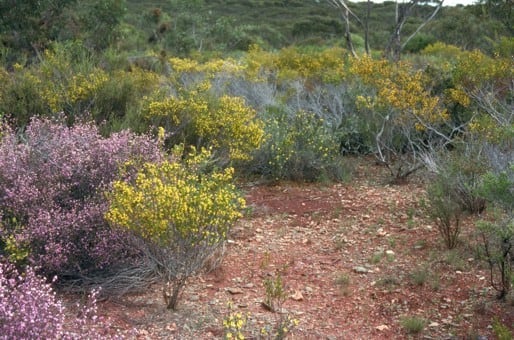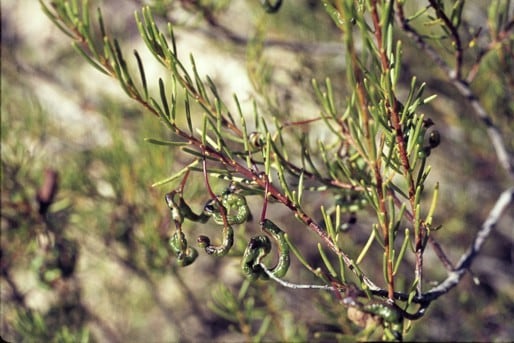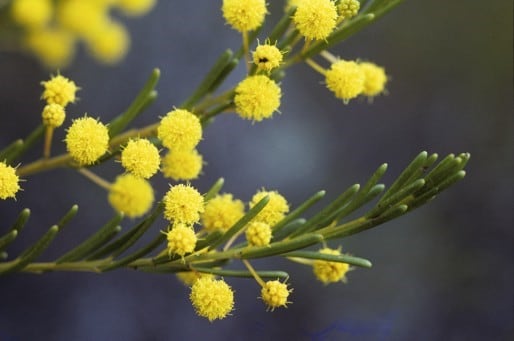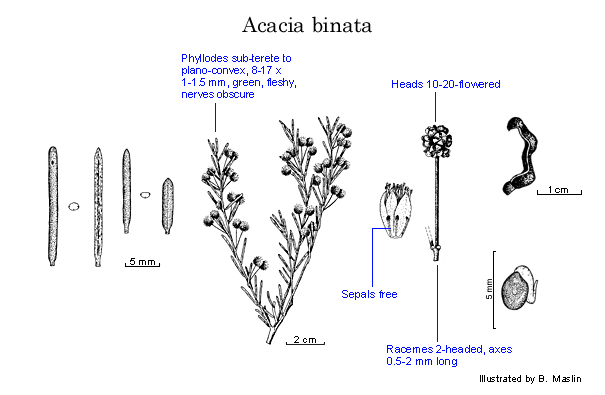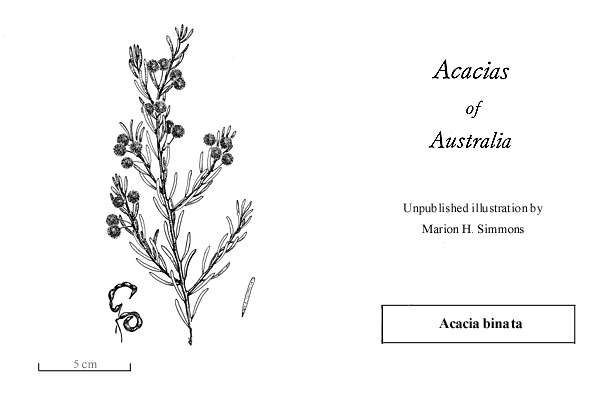Acacia binata Maslin
WATTLE
Acacias of Australia
Family
Fabaceae
Distribution
Occurs from near Ongerup E to Mt Beaumont (c. 90 km NE of Esperance), south-western W.A. A variant from the Lake King–Frank Hann Natl Park area is discussed below.
Description
Glabrous shrub commonly 0.3–0.8 m high, dense and rounded when young, becoming open and obconic with age. Phyllodes subterete (i.e. slightly depressed) to planoconvex, often flattish when dry, usually 8–17 mm long, 1–1.5 mm wide, obtuse, fleshy, drying longitudinally sulcate, usually green, obscurely 3-nerved. Inflorescences 2-headed racemes; raceme axes 0.5–2 mm long; peduncles (4–) 6–15 mm long, sometimes recurved in fruit; basal bract ovate, c. 0.5 mm long; heads globular to slightly obloid, 3.5–5 mm diam., usually 10–20-flowered, golden. Flowers 5‑merous; sepals free. Pods usually curved to openly and commonly irregularly 11/2-coiled, undulate, to 3.5 cm long, 3–3.5 (–4) mm wide, firmly chartaceous to thinly crustaceous, ±black. Seeds longitudinal to slightly oblique, oblong-elliptic to ovate, 2.5–3 mm long, usually grey to grey-brown; aril ±2/3 length of seed.
Habitat
Grows in loam and clay in open scrub, tall shrubland and tall open shrubland.
Specimens
W.A.: Floater Rd, c. 8 km N of Ravensthorpe township, B.R.Maslin 4770 (AD, MEL, MO, PERTH); c. 1 km due NW of Mt Ney, B.R.Maslin 5818 (PERTH); 5 km E of Ravensthorpe, P.G.Wilson 5532 (AD, BRI, K, MEL, PERTH).
Notes
A variant from the Lake King–Frank Hann Natl Park area probably deserves infraspecific recognition (e.g. 32 km E of Lake King, R.Hnatiuk 760791, PERTH). It differs most obviously in having 6–8-flowered heads, ±oblong rather than linear-spathulate sepals 0.2–0.4 mm long (1/4–1/6 or less the length of petals) rather than 0.5–0.8 mm (±1/2 petal length), pods to 1.5 cm long, ±straight, mid-brown and lightly pruinose when young and black seeds. The phyllodes are 7–12 mm long and judging from dried specimens are sometimes glaucous and branchlet extremities lightly pruinose.
Closely allied to A. diaphyllodinea and A. crassuloides which have raceme axes which are very short or absent altogether, a much longer, cucullate or rostriform basal peduncular bract and obliquely arranged, differently coloured seeds. Narrow phyllode forms of A. leptospermoides subsp. leptospermoides, which appear similar, have connate stipules, simple inflorescences and narrower, non-black pods. (For description and references concerning diaphyllodes, see discussion under A. diaphyllodinea). Sometimes sympatric with and superficially resembling A. ophiolithica.
FOA Reference
Data derived from Flora of Australia Volumes 11A (2001), 11B (2001) and 12 (1998), products of ABRS, ©Commonwealth of Australia
Author
Minor edits by J.Rogers
B.R.Maslin
This identification key and fact sheets are available as a mobile application:
URL: https://apps.lucidcentral.org/wattle/
© Copyright 2018. All rights reserved.
